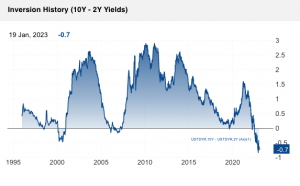Yield Curve inverts more than the last four recessions
NEW YORK, US, January 20, 2023 /EINPresswire.com/ -- The 10Y - 2Y US treasury yields, Powell's most mentioned indicator, now stands at -0.7%. This makes the curve more inverted than it has been in the past four recessions.
The bond king, Jeffrey Gundlach, who observes ten-year minus three-month yields for investing, recently stated, "We haven't seen the threes-tens this inverted really since the early 80s."
The Yield Curve is a chart of interest rates (yields) demanded by the market for US govt issued bonds. The short-term end of the curve shows the interest rates (yields) the US govt. has to pay to the investors for one-month to two-year debt. Similarly, the long-term end shows the yields for 10-year to 30-year debt.
Why do economists and investors follow the yield curve?
Yield Curve is a summary of investor's view on the markets. Typically, any capital intensive business needs to fund its projects on short-term loans. However, the projects start providing revenues in long-term. So, short-term end of the yield curve is reference to the cost of businesses and long-term refers to the reward.
This risk-reward is calculated as the difference between the long-term and short-term yields. One such indicator, the 10-year yields minus the 2-year yields, is used by market watchers to measure this risk-reward.
A positive value for this means that rewards of investing in long-term projects are greater than risks. This encourages business to make big capital investments to grow their businesses. On the other hand, a negative value means that risks are more than the reward or the "yield curve is inverted". This puts brakes on any long-term capital investments by the companies. Historically, this had led to recessions. Today, the curve is more inverted than ever in history, except the Volker era.
Rishi
Grufity.com
contact@grufity.com
Visit us on social media:
Twitter

